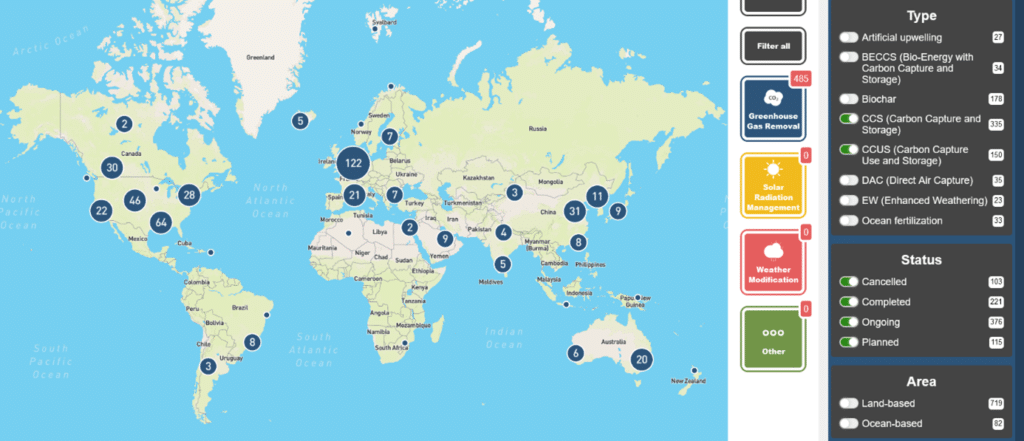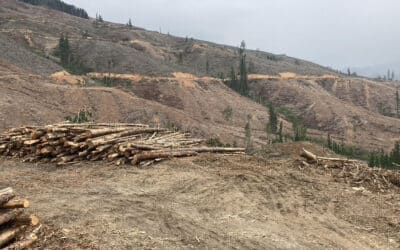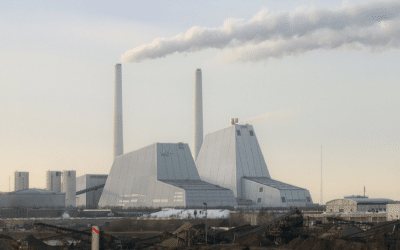By Anja Chalmin
The fossil fuel industry has a stake in the majority of known CCS and CCUS projects
Carbon capture and storage (CCS) and carbon capture use and storage (CCUS) fall into the category of Carbon Dioxide Removal (CDR) geoengineering technologies that hypothetically aim to remove greenhouse gases from exhaust gases and the atmosphere. Both greenhouse gas removal (GGR) technologies, CCS and CCUS, focus on capturing CO2 from exhaust gases. CCS aims to bury the captured CO2 underground, in geological formations, theoretically for long-term storage. CCUS aims to “store” the captured CO2 in manufactured goods, such as synthetic fuels, plastics or chemicals, however, the CO2 is re-emitted once these products are consumed. Despite decades of research and extensive funding, these two CDR technologies cannot demonstrate any positive impact on the climate – the same applies to all other known geoengineering technologies.
The Interactive Worldmap on Geoengineering, hosted by the Heinrich Böll Foundation and ETC Group, provides an overview of known geoengineering projects, research and experiments around the world. As there is no complete record of geoengineering projects, the map is necessarily partial. The map currently documents more than 800 CDR projects – CCS and CCUS account for more than half of them. About 40 % are CCS projects and just under 20 % are CCUS projects. Most of these projects are located in North America, Europe and Asia. The following screenshot of the geoengineering map shows the geographical distribution of the known CCS and CCUS projects:

Figure 1: Geographical distribution of the known CCS and CCUS projects. Extract from the Interactive Geoengineering Map (10/2021): https://map.geoengineeringmonitor.org/
The map features CCS projects in every stage of development from planning to completion. In addition to sites where CO2 is captured and injected into depleted oil and gas reservoirs or other geological formations, other relevant locations are featured, including industrial projects and companies that further develop and market CCS technologies. Known CCUS projects on the map include companies that develop and market CCUS, as well as companies where CCUS technology is applied, e.g., the Haru Oni project in Chile plans to use North American CO2 capture technology.
Using the data collected in the Geoengineering Map, the number of CCS projects that directly involve the fossil fuel industry as either a sponsor or project partner has been assessed. The data shows that the fossil fuel industry is involved with about 85 % of the known CCS projects. It can be assumed that fossil industry participation is actually higher than 85 %, given that not all CCS projects disclose all of their sponsors. Fossil fuel companies involved in CCS projects include, among others, BP, ConocoPhillips, Enhanced Energy, Equinor, Gassco AS, INEOS, PEMEX, Perdure Petroleum, Petrobras, Santos, Shell, Total, TUPRAS and Vattenfall. Companies from energy-intensive industries are also frequently involved in CCS projects, including companies from the steel, cement, chemical and mining sectors, among them ArcelorMittal, CEMEX, ENID and the De Beers Group.
For many of the known CCUS projects, the financial backers are not published and the funding of the projects is thus non-transparent. Therefore, it is not possible to determine the extent to which the fossil industry is involved as a financier in these projects. However, even without the exact funding information, fossil fuel industry participation can be demonstrated for almost 70% of the known CCUS projects, as companies from energy-intensive sectors act as project partners:
- The fossil industry is a project partner in about 20 % of the known CCUS projects, including companies such as BP, Capital Power Corporation, Chevron, ExxonMobil, Romgaz, RWE, Shell, Total, Uniper,…
- The chemical industry engages in almost 20 % of the known CCUS projects, e.g., in CO2-based production of ethanol, methanol and urea, including companies such as Bayer, Indo Gulf Fertilizer, LanzaTech, Pacific Ethanol, POET LLC,…
- Companies from the transport and aviation sector are engaged in almost 15 % of the known CCUS projects, especially in projects for the generation of synthetic fuels, including companies such as Audi, Boom Supersonic, British Airways, BMW, Lufthansa, Swiss,…
- Involvement of companies from the construction sector is evident in just under 15 % of the known CCUS projects, including companies such as Boral Limited, Cementos Argos, CEMEX, Omya AG and Shougang,…
This demonstrates a pronounced interest of the fossil industry in CO2 capture and “storage” projects.
EOR plays a major role in CCS projects
This chapter analyses how the CCS projects plan to dispose of the captured CO2. A report released by the Global CCS Institute on the Global Status of CCS in 2020 offers precise information on this. The report lists 28 commercial CCS plants under construction, in advanced stages or in early development. Of 23 projects, over 80 %, plan to use Enhanced Oil Recovery (EOR) – and thus increase oil production. EOR means that captured CO2 is compressed and pumped into oil reservoirs to extract the remaining deposits from ageing oil fields or otherwise inaccessible oil. This means that CCS is used to extract more fossil fuels. This is also confirmed by the 2019 report “Fuel to the Fire: How Geoengineering Threatens to Entrench Fossil Fuels and Accelerate the Climate Crisis” by the Center for International Environmental Law (CIEL). The report confirms that most large-scale CCS projects use captured CO2 for EOR and suggests that 85 % of US subsidies for CCS go to enhanced oil recovery.
The fossil industry tries to present a very different picture. For example, Shell describes CCS as a technology that “stores carbon dioxide deep underground, preventing its release into the atmosphere“. And yet another example among many: the Norwegian Petroleum Directorate (NPD) describes CCS as a mean “to limit emission of CO2 to the atmosphere by capturing CO2, and then storing it safely”. The marketing image that the fossil industry is trying to maintain is not consistent with research findings on CCS and the large share of EOR:
- EOR creates additional extraction volumes, e.g., the United States Department of Energy estimates that it is possible to double the U.S. oil production with EOR. Boosting oil extraction does not reduce emissions, but increases them.
- The safe storage of captured CO2, repeatedly described by the fossil industry, also does not correspond to reality – because oil industry estimates that around 30 % of the CO2 piped to an EOR site will be directly emitted back to the atmosphere. Of the remaining, long-term secure storage cannot be guaranteed, because CO2 can escape through leaks for several reasons, among them faulty constructions and underground movements.
- CO2 capture, liquefaction, transport and underground injection require significant amounts of energy. For example, due to energy-intensive CO2 capture, a power plant with CCS burns up to 30 percent more fossil fuels to produce the same amount of energy – which leads to an increase in emissions.
The fossil industry is trying to market CCS as a safe way to store CO2 in order to do business as usual. If this strategy is successful, EOR, among others, will lead to even more fossil fuels being extracted, resulting in more emissions. However, the UNEP Production Gap Report (2020) makes it clear that the amount of fossil fuels extracted needs to decrease, not increase, in order to limit global warming to 1.5°C.
CCS and CCUS technologies are still in their infancy – despite substantial public funding
CCS research continues to be supported with extensive public funding. In Europe, CCS research into underground storage of CO2 has been funded since 1990. In 2009, for example, the European Union allocated one billion euros specifically to CCS projects. The U.S. government has funded CCS research since 1997, with more than US$ 5 billion allocated since 2010. The International Institute for Sustainable Development (IISD) illustrates the extent to which the fossil fuel industry is generally supported with public funds: G20 governments support fossil fuels with at least three times the amount of public funding per year (US$ 77 billion) compared to clean energy (US$ 28 billion). The IISD explains that fossil fuel subsidies lower the price of fossil fuels while further fuelling the climate crisis.
The Global CCS Institute’s latest annual report on the global status of CCS underlines how little CCS technology has progressed – despite decades of research and extensive funding. The world’s first offshore wind farm was implemented in the same decade as the world’s first CO2 injection project. Around 30 years later, wind energy is a mature, large-scale technology, while CCS is still in its infancy. During the last two decades, global wind energy capacity has increased almost 100-fold, from 7.5 gigawatts in 1997 to 743 gigawatts in 2020. The Global Wind Energy Council states that wind power thus helps to avoid over 1.1 billion tonnes of CO2 worldwide – equivalent to the annual carbon emissions of South America. By comparison, the International Energy Agency (IEA) states that “today, CCUS facilities around the world have the capacity to capture more than 40 Mt CO2 each year” – in this figure, the IEA includes EOR projects.
The following examples are provided to illustrate the ongoing technical, financial and environmental problems of CCS and CCUS:
- Petra Nova Carbon Capture Project, USA: This CCS project was operated by NRG Energy and JX Nippon Oil & Gas Exploration Corp. Despite high costs, estimated at US$ one billion, the project has captured less than two million tonnes of CO2 annually. Although the project received a total of US$ 190 million in public funding, it was discontinued in 2021 for financial reasons.
- ROAD- Rotterdam CCS Demonstration Project, the Netherlands: This CCS project was proposed by E.On, Electrabel and Alstom, intended to capture CO2 at a newly constructed coal-fired power plant and to inject the captured CO2 off the coast near Rotterdam. The project received more than € 200 million in public funding, but was cancelled for financial reasons.
- Many further CCS projects were abandoned for financial reasons – despite large amounts of public funding, among them the Antelope Valley Project (USA, US$ 400 million in public funding), the Sweeny Gasification Project (USA, US$ 3 million in public funding), the Belchatow Project (Poland, € 61 million in public funding), the Eemshaven Project (the Netherlands, € 30 million in public funding),…
- Enhance Energy (ACTL), Canada: The Alberta Carbon Trunk Line (ACTL) transports CO2 for EOR. According to Enhance Energy, these EOR activities could result in the recovery of up to an additional one billion barrels of oil. More than CAD 850 million in public funding has gone into the project – helping to finance further emissions instead of avoiding them.
- Hydrogen Energy Supply Chain (HESC) project, Australia: The project aims to gasify Australian lignite to produce hydrogen. The hydrogen is to be exported to Japan in liquefied form. During the hydrogen production process, CO2 will be captured and injected into offshore geological formations. The project received more than AUD 100 million in public funding. There is increasing doubt that the production of hydrogen from fossil fuels in combination with CCS makes sense in energy terms.
- Great Plains Synfuels Plant, USA: The lignite-fired plant is operated by Dakota Gasification, captures CO2, and transports captured CO2 via a 205-mile pipeline for EOR. This CCS project has been running since 2000. Despite its long runtime and lots of backers, it has only captured 1.9 million tonnes of CO2 so far.
- Gorgon CCS project, Australia: The Australian government supported the project with AU$ 60 million. The commissioning of the plant was subject to the condition, that Chevron must capture and inject at least 80 % of the CO2 emissions released at the site over a five-year period starting in July 2016. The gas started flowing in 2017, but the commissioning of the CCS project was delayed three times. In 2021, it became known that the CO2 injection system is sand-clogged. The Conservation Council of Western Australia demanded to shut the plant until it can demonstrate its CCS was working.
- SaskPower Boundary Dam, Canada: After four years of operation, the project captured an average of 0.6 million tonnes of CO2 per year. 90 % of the captured CO2 is transported via a 66 km -pipeline to an oil field for EOR. Since its start-up, the project was often confronted with technical problems, e.g., the maintenance costs in 2017 amounted to US$ 27 million.
- Ineratec GmbH, Germany: Ineratec, a spin-off of the German Karslruhe Institute of Technology, aims to produce synthetic fuel from captured CO2. The production process is very energy-intensive and as soon as the fuel is consumed, the captured CO2 is re-released into the atmosphere. The project is financed with public and private funds.
- Kiverdi Inc., USA: The company aims to convert captured CO2 into products such as protein and oil. The production process is very energy-intensive and the captured CO2 is re-released as soon as the products are consumed.
- LanzaTech, China: LanzaTech has developed a CCUS technology that captures CO2 from exhaust gases and converts it into ethanol. The conversion is done by microbes that feed on the CO2 and produce ethanol. The captured CO2 is re-released as soon as the ethanol is consumed.
- Figures from 2020 show that the amount of CO2 needed industrially is rather small. There is talk of 230 million tonnes of CO2 annually, of which 130 million tonnes are used for the production of urea and up to 80 million tonnes for EOR. According to the International Energy Agency, CCUS has been around since the 70s/80s – which means that the market for CO2 cannot have increased significantly for many decades. The high energy demand of CCUS is one reason for this.
Outlook
The fossil fuel industry tries to present CDR technologies like CCS and CCUS as a safe and effective technical solution to climate problems. However, CCS and CCUS have not been proven to be safe and effective. Although the technologies have been extensively subsidized and promoted for several decades – with both public and private funding – there has been no significant progress in their development. Many projects have been abandoned due to high costs or technical problems. While other technologies, e.g., wind power, have advanced by leaps and bounds and are actively avoiding CO2 emissions, CCS and CCUS technologies are still in the development and testing phase and have not yet contributed to mitigating climate change. Furthermore, CCS projects with EOR lead to the extraction of even more fossil fuels. The high energy demand of CCS and CCUS leads to the need for much more energy. With CCS and CCUS, the fossil fuel industry wants to give the impression of fighting climate change – in reality, it is more about protecting profits from coal, oil and gas production. It would not be the first time in history that the fossil industry manipulated facts about the climate in its favour. After decades of research, there is no evidence that CCS and CCUS can address the causes of the climate crisis or significantly reduce greenhouse gas emissions.



